The Versatility of Brick in Letterbox Design

In the realm of structure and layout, few materials can rival the undying enchantment and practicality of brick. While traditionally associated with building facades and masonry, brick has determined a new and progressive software in letterbox design. This article explores the versatility of brick in creating purposeful, aesthetically beautiful, and durable letterboxes, losing light on its myriad benefits and capacity layout opportunities.
1. The Timeless Appeal of Brick
Brick has been a staple in construction for hundreds of years, renowned for its durability and traditional aesthetic. Its rich texture, natural hues, and capacity to weather beautifully make it an appealing choice for diverse design applications. In the context of letterbox design, brick brings a unique combo of subculture and innovation, merging the conventional with the contemporary.
1.1 Historical Context
Historically, brick has been used substantially in both residential and industrial homes, offering a dependable and lengthy-lasting answer for constructing walls and facades. Its use in letterboxes keeps this tradition, improving the individual and appeal of current homes at the same time as maintaining a link to historical design principles.
1.2 Aesthetic Flexibility
Brick’s versatility lies in its potential to evolve to diverse layout patterns. Whether it’s a country farmhouse, a graceful urban residence, or a quaint cottage, brick may be tailor-made to supplement the overall architectural topic. The cloth’s inherent color variations and texture permit a wide variety of design opportunities, from traditional pink brick to extra contemporary finishes like whitewashed or glazed bricks.
2. Functional Benefits of Brick in Letterbox Design
2.1 Durability and Longevity
One of the primary benefits of the use of brick for letterboxes is its excellent sturdiness. Brick is immune to weathering, pests, and physical wear, ensuring that a brick letterbox can face up to the check of time. Unlike some materials that might become worse or require common renovation, a well-built brick letterbox can continue to be purposeful and appealing for many years.
2.2 Low Maintenance
Brick’s low-maintenance necessities further decorate its enchantment. Unlike timber letterboxes that can need ordinary portrayals or metallic ones that may rust, brick is preservation-loose. Occasional cleaning and inspection are generally sufficient to preserve a brick letterbox in top situations, making it a practical desire for house owners looking for a hassle-unfastened solution.
2.3 Security
The robustness of brick affords an brought layer of security for mail and packages. Brick letterboxes can be designed with secure, lockable compartments that are tough to tamper with. This security feature is especially precious for regions prone to mail robbery or vandalism.
3. Design Considerations for Brick Letterboxes
3.1 Size and Proportions
When designing a brick letterbox, length and proportions are essential. A letterbox should be massive and sufficient to house popular mail and packages however now not so big that it overwhelms the belongings’s standard design. Customizing the scale and proportions of the brick letterbox to fit the scale of the assets ensures harmony and functionality.
3.2 Integration with Existing Architecture
A well-designed brick letterbox ought to seamlessly combine with the belongings’s existing architecture. This way matching the brick’s shade, texture, and style to the encompassing factors, inclusive of the residence’s brickwork, landscaping, or fencing. For instance, a letterbox designed to complement a historic brick domestic might use conventional crimson bricks, at the same time as a modern-day residence might gain from an extra streamlined, modern-day brick finish.
3.3 Customization Options
Brick offers various customization options, permitting owners to create a letterbox that displays their non-public fashion. Custom brick patterns, decorative inlays, and unique shapes can be integrated into the design to feature visible interest and persona. Additionally, brick may be mixed with different substances, inclusive of metallic or wood, to create a special look.
3.4 Address and Identification
Incorporating deal with numbers and identity capabilities into the brick letterbox layout is important for practicality. Options encompass engraving numbers directly into the brick, affixing metal plaques or the usage of built-in lighting to focus on the deal with. Ensuring that these capabilities are both useful and aesthetically pleasing contributes to the overall fulfillment of the design.
4. Innovative Design Ideas for Brick Letterboxes
4.1 Minimalist Modern
For a minimalist contemporary aesthetic, do not forget the usage of glossy, uniform brick with easy traces and easy geometric shapes. A minimalist brick letterbox would possibly function as a clean facade with a discreet, integrated mail slot. The recognition here is on simplicity and elegance, with an emphasis on functionality.
4.2 Rustic Charm
A rustic brick letterbox can decorate the charm of a rustic home or cottage. Opt for reclaimed bricks with varying textures and colors to create a weathered, vintage look. Adding elements consisting of a thatched roof or wood accents can further enhance the rustic appeal.
4.3 Contemporary Fusion
Combine brick with different substances for a cutting-edge fusion design. For example, a brick letterbox with a glass or steel front panel can create a placing contrast and a modern-day feel. Incorporating factors like LED lighting or geometric styles also can add a hint of sophistication.
4.4 Sculptural Statements
For an ambitious assertion, a sculptural brick letterbox can serve as a focal point inside the panorama. This approach entails designing the letterbox as a chunk of art, incorporating specific shapes, patterns, and textures. A sculptural brick letterbox can come to be a communication piece and a standout characteristic of the belongings.
5.1 Sustainable Materials
Brick is a green fabric with a low environmental impact. Many bricks are crafted from herbal clay and are produced with minimum power consumption. Additionally, brick’s sturdiness and sturdiness lessen the need for common replacements, contributing to a greater sustainable approach to design.
5.2 Energy Efficiency
Brick has extraordinary thermal mass homes, that means it can help alter temperature and decrease the want for added heating or cooling. Although this is greater applicable to constructing facades, a brick letterbox also can make contributions to the overall electricity efficiency of the belongings by minimizing warmness loss or advantage in its location.
5.3. Reclaimed Brick
Using reclaimed brick is an amazing way to beautify sustainability. Reclaimed bricks, salvaged from old homes or systems, offer a unique man or woman and assist reduce waste. Incorporating reclaimed brick into a letterbox layout not only provides historic significance but also supports environmentally accountable practices.
6. Conclusion
The versatility of brick in letterbox design highlights the cloth’s enduring appeal and realistic advantages. From its undying aesthetic to its purposeful sturdiness, brick offers a variety of possibilities for creating letterboxes which are each beautiful and functional. By considering factors that include length, integration, and customization, homeowners and designers can craft letterboxes that beautify the assets’s average design whilst reflecting non-public fashion.
As we explore progressive design answers, brick remains a standout choice for letterboxes, blending tradition with modernity in a way that few substances can be healthy. Whether via minimalist modern-day designs, rustic appeal, or present-day fusion, brick’s adaptability guarantees that it’s going to continue to be a desired fabric in letterbox layouts for years yet to come.



